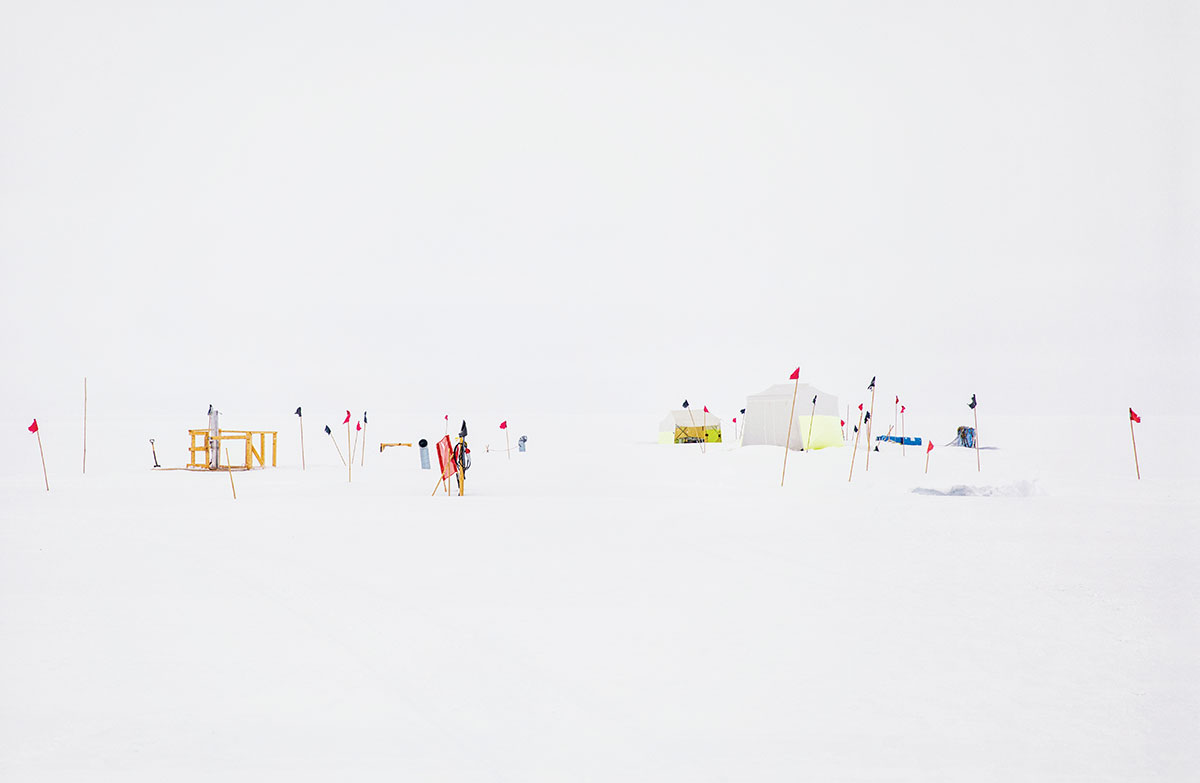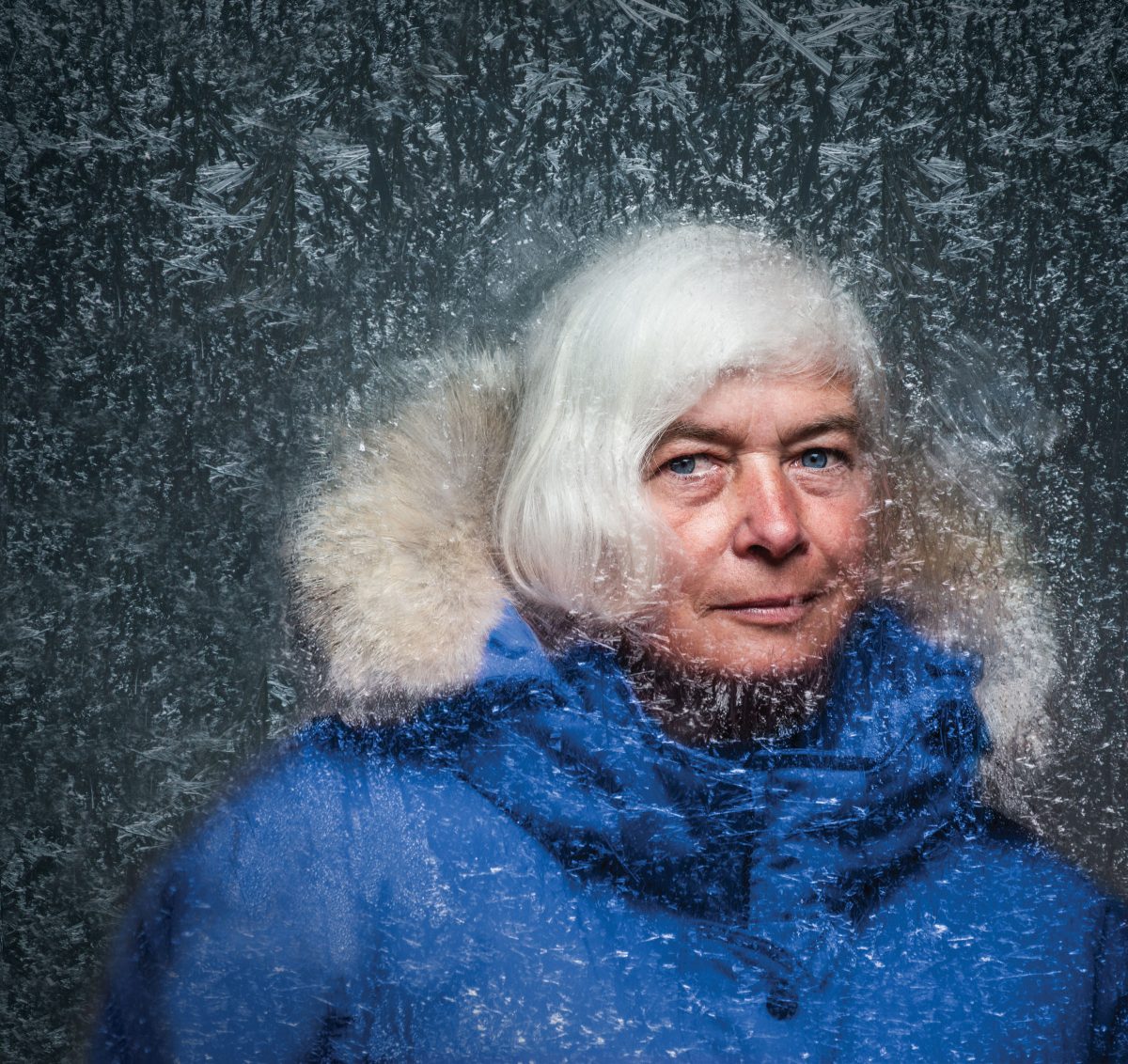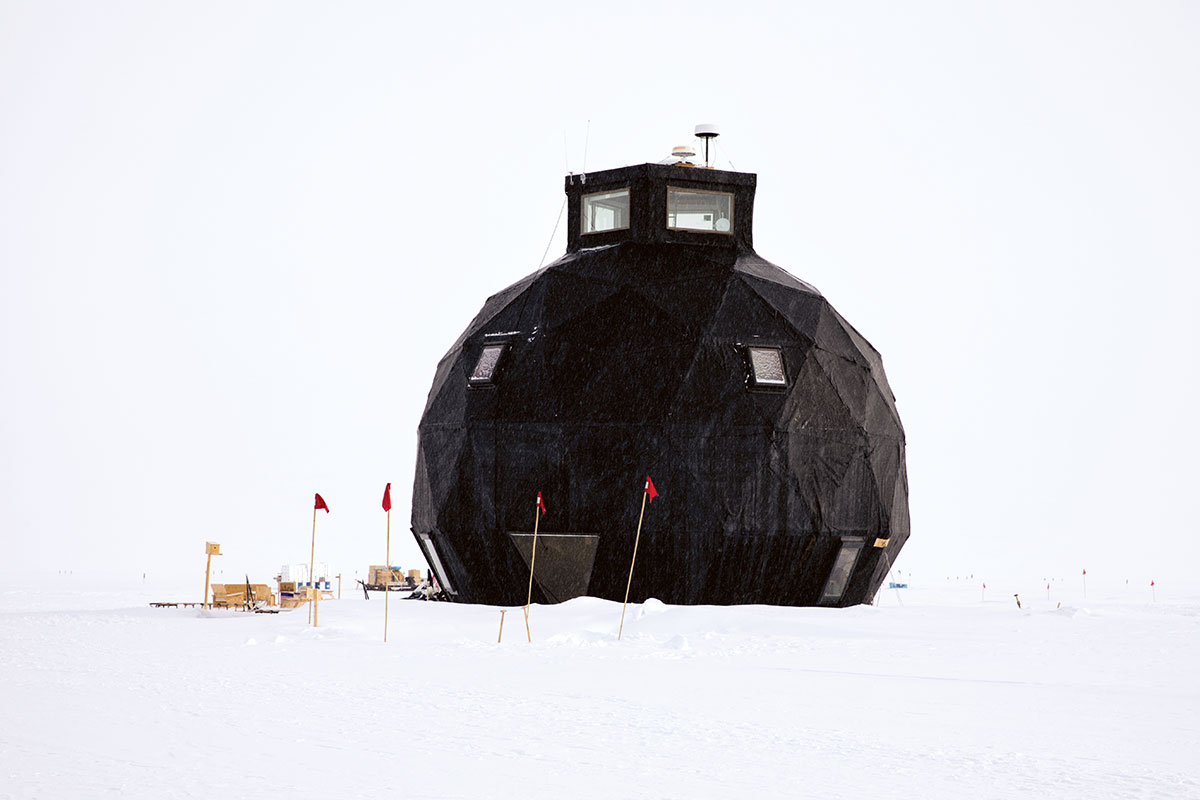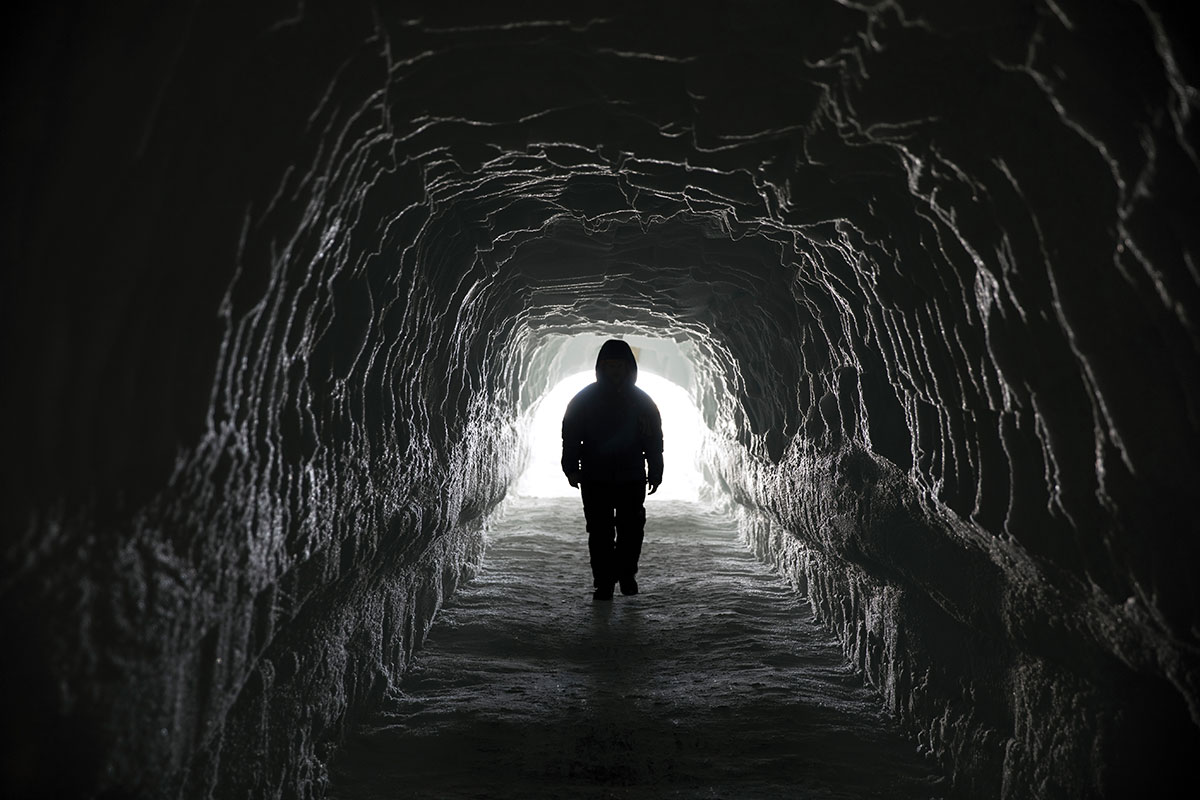On the Greenland ice sheet, they dance.
Come Saturday night, researchers tasked with better preparing our planet for possible impending doom take a breather, put on their fancy dress clothes and groove to ABBA.
Among the regulars: Danish scientist Dorthe Dahl-Jensen, who’s made this glacial island her workplace every summer for 40 years. She loves how the snow and overcast sky merge without horizon—“like a white desert,” she says.
Ten metres below the surface is where the palaeoclimatologist, and the international team she leads, spend their Sunday to Friday, exploring an entombed history.
In parkas and insulated boots, they descend through a tunnel toward an underground lab carved out of the icy snowpack. This cave-like “science trench” serves as a natural freezer for their unusual specimens: pieces of ice up to one million years old.
Bit by bit, year after year, the East Greenland Ice Core Project crew has drilled to bedrock—some 2,600 metres—retrieving ice cores and unlocking their cryogenic secrets. Unlike sea ice, which can break up every year, the Greenland sheet offers a unique repository, since it holds ice that has never once thawed.
Each component trapped within reveals a snapshot and narrative of life from thousands of years ago. The chloride: just how intense the sun was. The isotopes (or variants of an element): how much snow fell, how cold it got in winter, and how hot in summer. The impurities, saline and minerals: what the ocean’s currents were like, which way the wind blew and what kinds of storms hit.
When they find volcanic ash from a historic eruption, it calls for a celebratory high-five.
“You’re looking at this ice—just clear, clear ice—and you’re standing there with a bit of history in your hand. You’re the detective, and you find this ice from when Jesus was born,” she says.
By piecing together an archival record of Earth’s behaviour, Dahl-Jensen is providing data for the world’s scientists to reconstruct the conditions of the past, identify patterns, and tell us with greater confidence if our grandkids’ grandkids will grow up on a planet too inhospitable to go out for an ice-cream cone.
She’s also opening our eyes to historical, abrupt warmings that have happened not once but many, many times—they are significant shifts that no one seems to be talking about but should be, Dahl-Jensen insists. The big problem with today’s conversations about climate change is they’re far too narrow in scope, only scanning the last century of observational records, she says. What about conditions that could repeat from the last millennium and beyond? And what if natural shifts were to collide with our man-made warming?
“You’re looking at this ice—just clear, clear ice—and you’re standing there with a bit of history in your hand. You’re the detective, and you find this ice from when Jesus was born.”
Few climate models have the capacity to work with these abrupt changes. “In that way, we are not prepared to simulate them or predict them, which is quite scary,” she says.
Dahl-Jensen’s expertise has captured an eclectic audience beyond fellow scientists. At the research station, she’s hosted members of the royal families of Norway, Sweden and Denmark. Queen Margrethe II even made her a Knight (of the Order of Dannebrog.) She’s been an authoritative voice for U.S. Republicans like the late John McCain, who confided his struggles to convince colleagues to take climate change seriously.
Former U.S. Vice-President Al Gore also sought Dahl-Jensen’s expertise. She recalls when the two were on a panel together and faced ire from a Danish politician, who questioned whether he could trust researchers since their story was always shifting. Gore’s impatient retort sent the minister storming out of the room and prompted another minister to mutter to Dahl-Jensen: “Good luck getting another grant.”

On the Greenland ice sheet, where visibility can be low, flags help mark camp boundaries. The research site operates in these remote and extreme conditions for 90 days a year // photo by ANNA FILIPOVA
Climate change, she had explained, is much like the financial crisis of the day: complicated, hard to predict. Still now, a decade removed, she finds the unknowns deeply unsettling.
But what they do know—from their study of ice from a glacial period stretching 12,000 to 115,000 years ago—is that intense warming can happen in as little as 100 years. They also have an idea of which conditions were at play.
Ice cores from that time showed that roughly every 2,000 years, the temperature over Greenland jumped by 10° to 15° C, soaring from -55° to -40°C. “The abrupt warming is, you know, so impressive. It’s really mind-breaking,” says Dahl-Jensen. “And to try to understand: How can the climate do this? It’s been quite a riddle to try to figure out what’s going on and why it’s happening.”
Scientists believe it’s related to the melt of the Laurentide ice sheet that covered North America 25,000 years ago, along with an accompanying exchange of energy between the northern and southern hemispheres, Dahl-Jensen says.
“There are not external reasons for these changes. It’s a total internal system that just shifts the temperature over and [shifts] energy around on Earth and causes these very big changes.”
During these shifts, the ocean currents—which circulate to warm and cool our planet—shut down. What if our modern-day tampering with the environment creates similar conditions?
A surge of fresh water into our oceans—from the melting of the Greenland ice sheet, for example—could also slow currents or stop them entirely, says Dahl-Jensen, who often refers to the ice sheet as “a sleeping giant.”
“When we warm our climate, will we get into a regimen where the climate is capable of making these swings again? Because I think that could be one of the most disastrous things that could happen to us. If we change the ocean current, can we invoke such an abrupt change again?”
WAKING THE GIANT
In her role as the University of Manitoba’s newly minted Canada Excellence Research Chair in Arctic Ice, Freshwater-Marine Coupling and Climate Change, Dahl-Jensen will expand her focus from inland ice to open water in order to further investigate how the Greenland ice sheet’s discharge into the Arctic Ocean could change currents and other environmental conditions, based on what’s happened historically.
Dahl-Jensen came to the UM’s Centre for Earth Observation Science from the University of Copenhagen; the new position is accompanied by $20 million in federal and provincial government funding, spanning seven years. Her modelling to date suggests we’ll experience a 2° C warming globally, and a 5° to 8°C jump in the Arctic, by 2100 (but more likely sooner, she says, if we don’t act to reduce emissions from greenhouse gases). This warming would likely raise sea level one metre. With UM students in tow, she’ll retrieve ice from 5,000-8,000 years ago, when temperatures were similar. They’ll drill at Müller Ice Cap on Axel Heiberg Island, near Baffin Bay.
Among the answers they’re looking for: how much sea ice and open water there was back then (this could inform dialogue on opening shipping routes in the Arctic); and what conditions upset aquatic life then and could do so again (knowing would bolster policies set by northern communities who rely heavily on the marine ecosystem).
A better understanding of all these key players will also help to solidify current, best-guess predictions on how high sea level might rise; the current margin of error is uncomfortably wide.
“[The rise] could be between four centimetres and 1.5 metres,” says Dahl-Jensen, noting the higher the level, the more conducive the conditions for extreme weather. “It’s scary that we can’t predict it with a higher accuracy. That’s an enormous area of uncertainty—it’s the world’s most dangerous uncertainty. A very big part of the Earth’s population lives close to the coast.”
When a heat wave hit Greenland this summer, images of slushy surfaces on the ice sheet made headlines, with reports of a melt equivalent to 80 million Olympic-sized swimming pools in July alone—three times higher than its average for that time of year.
Snow is steadily falling, which turns to ice and forever replenishes the sheet. But could we lose it in its entirety, which would raise sea level a staggering seven metres? Dahl-Jensen doesn’t think so. Her analysis of ice from the warming period of 115,000 to 130,000 years ago—back when there were boreal forests— suggests it would still exist even if it were 8 °C warmer than now (but a jump like that would certainly disrupt food sources, rain regions, and where we live—and could trigger territory wars).
“[The rise] could be between four centimetres and 1.5 metres. It’s scary that we can’t predict it with a higher accuracy. That’s an enormous area of uncertainty—it’s the world’s most dangerous uncertainty.”
“We still had the Greenland ice sheet, so this tells us that even though it warms quite a lot, the Greenland ice sheet will not just disappear. Greenland is losing more and more mass every year, but it’s just such a big lump of ice, it’s not going to just disappear overnight. It depends on how long the warming will last. If it continues for 1, 000 years, it will be at risk.”
She says this on the eve of Denmark’s federal election, with polls showing climate change as a top-ranked issue on the country’s agenda. Dahl-Jensen is encouraged by Canada’s response, too, and irked by inaction from the U.S. and China. It’s going to take a collective effort from governments—and each person—to act to minimize greenhouse gases, which she predicts we’ll have high levels of for at least the next several hundred years. A mother of four (including three sons studying physics), she drives an electric car but favours her bicycle, and keeps a well-insulated house.
“For me, it’s not a doomsday scenario. It’s not too late now. I’m not afraid—for me it’s much more important to grab the opportunities now.”
LIFE ON ICE
Within days of heading back to her frozen working quarters on the Greenland ice sheet—what is the world’s largest island—Dahl-Jensen says she looks forward to hosting UM students in 2020 for what will be their final season, given their latest efforts are close to reaching bedrock.
With a population of about 30, the research site runs during the 24-hour sunlight of summer to avoid -60°C winter temps. The isolated, extreme conditions require ingenuity. How do they create the tunnels? They dig a trench, and within it, blow up giant balloons, cover the tops with snow, and then deflate them. How do they get food? A U.S. Air National Guard Hercules from upstate New York, equipped with landing skis, arrives once a month, carrying 10 tonnes—much of it frozen.
How do they sleep? Above ground, in large insulated tents called weatherports, with a frigid 200-metre walk to the bathroom tent (a red flag in the snow signals “occupied.”) If a machine breaks, they use a 3-D printer to make a new part. If there’s a medical emergency, there’s a physician among the crew (and anesthesia).
The researchers are still connected to the outside world, so much so they have a designated space where cell phones are discouraged in favour of board games. Even then, some can’t take the physical isolation and leave at the first chance.
“But most people can’t wait to get back,” says Dahl-Jensen, who as a kid would climb 20-metre ice walls on trips to Norway and Sweden with her mountaineering club.
Her mother was a pharmacist. Her father, a physicist in Geneva at the world’s largest particle physics lab, CERN. She grew up watching him use Lego to model ideas for new instruments to accelerate and collide beams of particles. She saw wins and fails—and has had her share.
One of her findings—an abrupt change during a warm period 120,000 years ago, which her team published in Nature in 1993—later proved to be something altogether different; it was actually a fold in the ice. The discrepancy revealed itself a year later, only once an American research team obtained different results, despite being their drilling neighbour on the ice sheet. “If you had told me, as a student, that ice was folding at the bottom because of some kind of turbulence, I would have thought it was crazy,” says Dahl-Jensen, who now sees the error not as a mistake but as one of the most exciting things to have happened in ice research.
The successes and surprises of climate change study are the kinds of things she and her colleagues ponder.
Except on Saturday night, when they happily draw the curtains in their main headquarters to block the midnight sun. Then turn on the disco lights.
photos by ANNA FILIPOVA












Great article. Interested in magazine.
So very interesting. I read the entire magazine with great interest.